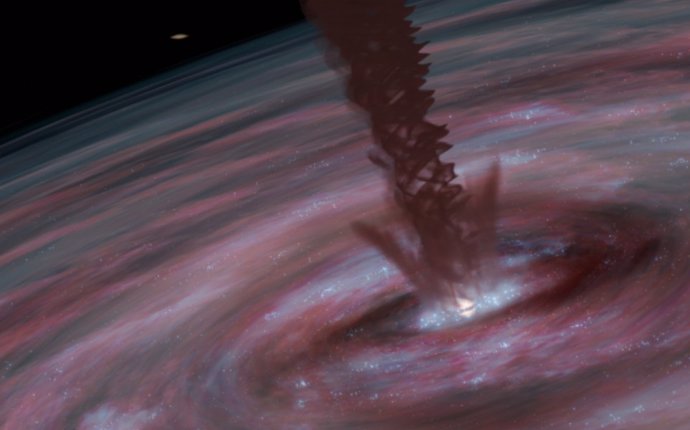In this illustration, the core of the galaxy is dominated by a rotating wind of dense gas heading outward from the supermassive (occult) black hole at the center of the galaxy. – MD GORSKI/AARON M. GELLER,
June 21. () –
Astronomers have discovered a powerful rotating magnetic wind which they believe contributes to the growth of a galaxy’s central supermassive black hole.
Most galaxies, including our own Milky Way, have a supermassive black hole at their center. How these black holes grow remains a mystery to astronomers. A team of scientists decided to study the relatively nearby galaxy ESO320-G030, just 120 million light years from Earth. This galaxy is very active and forms stars ten times faster than our own Milky Way.
Astronomers measured light from molecules carried by winds from the galaxy’s core, hoping to trace their origin to the supermassive black hole. The Atacama Large Millimeter/submillimeter Array (ALMA) was used to study this light, coming from the wavelengths of hydrogen cyanide (HCN) molecules, hidden in thick layers of dust and gas.
ALMA was able to see details and track movements in the gas, and discovered patterns that suggest the presence of a magnetized, rotating wind. While other winds and jets at the centers of galaxies push material away from their cores, Astronomers believe this newly discovered wind fuels the black hole to help it grow.
This process is similar to a much smaller-scale environment in space: the swirls of gas and dust that lead to the birth of new stars and planets.
“It is well established that stars, in the early stages of their evolution, grow with the help of rotating winds, accelerated by magnetic fields, just like the wind in this galaxy. Our observations show that supermassive black holes and tiny stars can grow through similar processes, but at very different scales,” he says. it’s a statement Mark Gorski, lead author of this research and member of the Center for Interdisciplinary Research and Exploration in Astrophysics at Northwestern University, and also affiliated with the Department of Space, Earth and Environment at Chalmers University of Technology (Sweden).



![[Img #74693]](https://thelatestnews.world/wp-content/uploads/2024/12/Give-a-second-life-to-your-mobile-with-iLevante-150x150.jpg)






![[Img #74693]](https://thelatestnews.world/wp-content/uploads/2024/12/Give-a-second-life-to-your-mobile-with-iLevante-300x200.jpg)

Add Comment